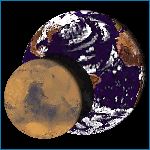| Proper Name | Mars | | Orbital Period | 687 days | | Distance from the Sun | Semi-Major Axis: 227,937,000 km (1.52 AU)
Perihelion: 206,645,000 km (1.38 AU)
Aphelion: 249,229,000 km (1.67 AU)
| | Eccentricity | 0.0934 | | Rotation Period | 24.6 hours | | Diameter | 6,794 km | | Mean Surface Temperature | 220 K (-53°C) | | Moons | Deimos, Phobos | | Parent star | The Sun, yellow dwarf | | Other planets in this system | Mercury, terrestrial planet
Venus, terrestrial planet
Earth, terrestrial planet
Jupiter, gas giant
Saturn, gas giant
Uranus, ice giant
Neptune, ice giant
Numerous dwarf planets, asteroids and other bodies
| | Notes | The fourth major planet from the Sun, Mars is distinctive for its red-orange colouration, broken only by icy white at the poles. Its diameter is only about half that of Earth. |

The broken and icy north polar region of Mars. Prominent against the whiteness is the dark gouge of the Chasma Boreale, the North Canyon.
The cold desert world of Mars lies further from the Sun than Earth. Considerably smaller than our own planet, Mars' atmosphere consists mainly of carbon dioxide.

Mars has a diameter a little more than half that of Earth. Nonetheless, because it has no oceans, its total land surface is similar to that of our own planet.
| 
A view down into the Valles Marineris, an immense complex of valleys more than four thousand kilometres in length, running between the volcanic plains of Tharsis and the densely cratered landscape of Chryse.
|
Equatorial view centred on longitude 0°
Equatorial view centred on longitude 90° West / 270° East
Equatorial view centred on longitude 180°
Equatorial view centred on longitude 270° West / 90° East
|
|
v2.1g
eSky © copyright Mark Fisher 1999-2026
Surface maps courtesy Jet Propulsion Laboratory. Copyright © California Institute of Technology, Pasadena, CA. All rights reserved.